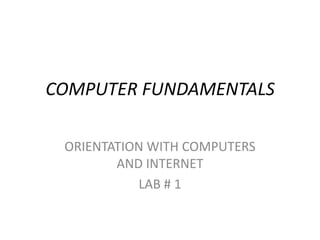
Computer Fundamentals
- 1. COMPUTER FUNDAMENTALS ORIENTATION WITH COMPUTERS AND INTERNET LAB # 1
- 2. Some basic definitions • Hardware: The physical components of a computer system that we can touch are known as hardware. Examples: Keyboard, mouse, monitor etc • Software: The components of a computer system that we cannot touch are known as software. Examples: Windows, Ms office, Media player Types :- • Application Software Examples are window media player, Ms office, VLC etc.. • System Software Windows are the main examples of system software as Xp, Vista, Win 7, Win 8 etc
- 3. Connectivity and communication • Connectivity:- Connectivity is hardware based, without media it is not possible Examples of media are:- Cables, Wires, RF • Communication:- Communication is software based and without addresses are not possible
- 4. Address: • Serve as a unique identifier for a computer. • Addresses types:- Two types of address 1) Physical address 2) Logical address
- 5. Physical Address • Also known as MAC address(Media Access Control) • It is unique and cannot be changed • 12 digits Hexadecimal • 48 bit length
- 6. How you can check physical address for your computer? • 1st way • Run cmd ipconfig/all Enter
- 7. The screen will look like
- 8. 2nd Way
- 9. Logical address • Logical address is an IP address • Ipv4 is 32 bit address For example: • 192 . 168 . 13 . 10 8bit 8bit 8bit 8bit • Total 4 octets • One octet = 28 = 256 0 255
- 10. DNS server • The Domain Name System (DNS) is a hierarchical distributed naming system for computers, services, or any resource connected to the Internet or a private network. • For example, the domain name www.example.com translates to the addresses 192.0.43.10 (IPv4) http://www.apcoms.edu.pk
- 11. How to connect with server? • Start menu • Run.. • Type this address • 192.168.13.1 or 13.2
- 12. Connect with internet? • Open Mozilla Firefox • Click on Tool • Option • Advanced • Network • Settings select manual proxy configuration • 192.168.13.7
- 13. Computer Commands (Run Commands) • Gpedit.msc • Administrative Templates 1. Control Panel a) Display settings b) Personalization c) Printers 2. Desktop 3. Network a) Network connections b) Start Menu and Taskbar 4. System a) Prevent access to Command Prompt b) Prevent access to Registry Editing Tools c) Alt+Ctrl+Del Option d) Driver Installation
- 14. Computer Commands (Run Commands) • Msconfig a) General b) Boot c) Services d) Startup e) Tools
- 15. Alt-Ctrl-Del Option a) Lock This Computer b) Switch User c) Log off d) Change Password e) Start Task Manager
- 16. Manage Computer • Users • Groups
- 17. How to Create new Users ? • Right click on Users option • Select new user • A window appear • From here you can create new user • You can apply some settings with select the checkboxes
- 18. Group Management • Double click on groups • There are many options if you select first option(that is Administrator) • Double click on Administrator • Add new user that you already created in this group (This mean you are adding this new user in administrator group then automatically this new user will have all rights of administrator).
- 19. Disk Management • Apply rights on Disks: a) Select any Disk b) Right click on Disk c) Properties d) Select Security e) Click on Edit f) From here add that new user g) Select this user and select check boxes for permissions
